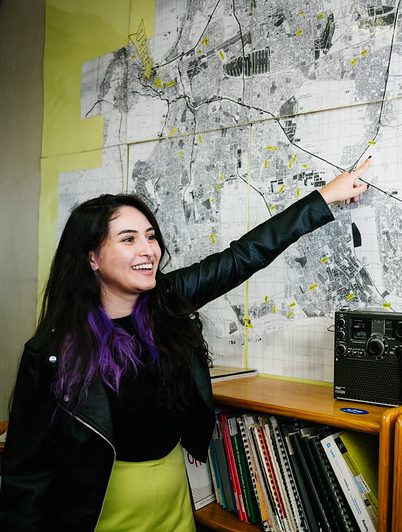RESOURCES
2024-03-13
The Benefits of a Collaborative Culture
If you’ve ever been in a classroom, on a team, or even in the workplace, you know that overall success requires a culture of collaboration and support.
When a culture of collaboration collapses and is replaced by hostile competition, teams fall apart, projects are neglected, and no one wins.
Published by Tilting Futures

Tilting Futures is cultivating a global community of young leaders that wish to change the world for the better. We recognize that to achieve meaningful change, we must ensure that students know how to build and support collaborative cultures, so we put together a guide to help you understand, build, and maintain collaborative cultures within your personal and professional endeavors.
What is a collaborative culture?

In order to build and support collaborative cultures, you first must understand what a collaborative culture is and what it looks like.
A collaborative culture is a culture where collaboration is understood as a key ingredient for success. Collaboration should be built into everyday processes rather than just being utilized when it’s convenient or when you have a project that requires more than one person to complete.
What does a collaborative culture look like?

It is possible to build a collaborative culture in any environment. Here are some examples of what collaborative cultures may look like in different environments:
School
A school with a collaborative culture will reflect in both teachers and students. Teachers will work together to set goals and make decisions and administrators will work alongside teachers to ensure that the needs of all students are being met. This culture of collaboration will trickle down to the students and empower them to do the same.
Students that go to schools where collaboration is not only recommended but is a part of the curriculum will take leadership seriously and consider the needs of the school as a whole. The students will be drivers for creating meaningful changes in the classroom. Communication and compromise will be expected and integral to ensuring that the students and teachers are working together to enhance the school’s curriculum, processes, and culture.
Athletic and Academic Teams
If you’ve ever been in a team sport or another extracurricular team activity you know that when competition trumps collaboration the team falls apart. A team with a healthy collaborative culture will consider the individual strengths and weaknesses of each team member and empower teammates to improve. When you are a part of a team with a collaborative culture competition will be healthy and motivational without being hostile and disempowering.
Workplace
A workplace with a collaborative culture will urge workers to work together to maximize productivity and creativity. Afterall, they always say that collaboration drives innovation. Being a part of a collaborative environment makes individuals more likely to feel energized and adaptable because a healthy exchange of opinions, strategies, and ideas will be prioritized rather than ignored.
Why are collaborative cultures important?

Our world is facing a gross lack of strong, influential, and compassionate leaders. We are facing devastating global challenges including the pandemic, racial injustice, and an imminent climate disaster. These challenges can not be solved by one individual or country alone, but with collaboration and communication on a global scale, we will have the power!
Overcoming our shared, global challenges requires a critical mass of leaders who represent society’s diversity, are equipped to work across lines of difference, and are committed to a purpose beyond themselves.

Considering a semester abroad?
See how Take Action Lab could align with your goals.
The benefits of a collaborative culture

Collaborative cultures bring out the best in the individuals involved by prioritizing a healthy exchange of ideas. Some benefits of a collaborative culture include:
Spreading of knowledge
When collaboration is encouraged, an open forum is created where members of any organization can exchange ideas, best practices, strategies, and acquired knowledge. By allowing individuals to share their experiences and expertise, organizations foster growth and development.
Greater Trust
Establishing trust within a team is integral to a team’s success. Collaborative cultures cultivate greater trust between individuals by encouraging transparency and communication. When individuals feel empowered to share their ideas freely without fear of hostility, trust builds and organizations thrive.
Greater Engagement
Because collaboration is an active and participative process, members of an organization are more likely to feel deeply invested and engaged in events or projects. When teams feel more connected and engaged, their work will be more thorough and authentic.
How to create collaborative cultures as a young leader
It is important to understand that creating a collaborative culture cannot be achieved by one person alone, but it only takes one person to plant a seed. Here are a few steps you can follow to help create a collaborative culture in any situations:
Start the conversation
If you are a part of a group that is lacking collaboration, it may be up to you to start the conversation and plant the seed. Most people will be receptive to hearing your thoughts especially if you are advocating for meaningful, positive change. Don’t worry, the first step is the hardest. Once you have people on board, the rest will be smooth sailing.
Establish Clear Goals
Once you’ve got a group of individuals that are on board and want to establish a culture of collaboration, it’s time to start collaborating. Sit down with one another and establish clear goals and expectations. Make sure that everyone’s voice is heard and considered without judgment.
Encourage Feedback
Now that you’ve been able to build a group and establish clear goals, it is critical that you keep the collaborative momentum going by encouraging regular feedback between all members of the group. By encouraging feedback, everyone within the group will be able to learn from each other’s experiences and expertise.
How Tilting Futures can help you build and support collaborative cultures

Tilting Futures is a nonprofit that wants to help you develop the skills that you will need to build and maintain collaborative cultures within your personal and professional life. At Tilting Futures, we offer immersive learning programs that have been designed to bring diverse groups of young leaders together to empower a culture of collaboration for solving our world’s biggest challenges.
Our latest program is called Take Action Lab. In it you will build powerful and connected communities across lines of difference. You will develop empathy to connect with people from a range of cultures, backgrounds, and economic classes.
In contrast to the cut-throat, competitive academic environments you’ll find in some schools or colleges, Tilting Futures creates a supportive and collaborative learning environment. It’s a space to be vulnerable, courageous, and connect with others on a deeper level.
If you’re interested in engaging in Tilting Futures’ global collaborative cohort, you can visit our Home Page to learn more!



